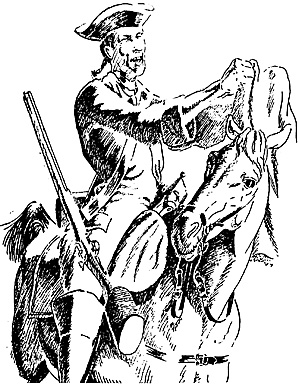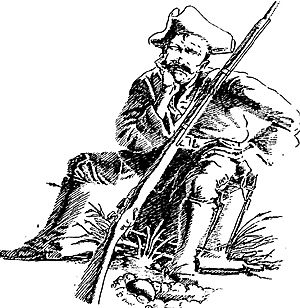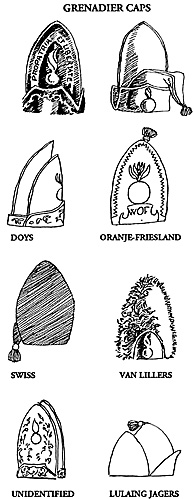 INTRODUCTION
INTRODUCTION
Uniforms in the Dutch Army were not regulated until 1749/1750 when the army underwent a complete reorganization. Prior to this, uniforms were the prerogative of the regimental commander Both the cut and color was at the discretion of the commander. The 1740's were also a period of transition as lapels and collars were introduced; coatskirts began to be turned- up; the position of the waist-belts changed from over to under the coat as coats began to be worn open; and different colored waistcoats disappeared to be replaced by straw or white colored ones.
None of these changes were governed by regulations. They were part of an evolutionary process carried out by the regimental commander after his own tastes and size of his purse. The result was an army unique in appearance with uniforms reflecting the influence of contemporary British, Austrian and French styles, as well as carryovers from previous decades.
Unfortunately, a great deal of specific information is lacking. That which is available is based on fragmentary information in scattered references, and, except for a few officer portraits, there are few contemporary illustrations. To make matters worse, none of the descriptions are very complete. For the most part only coat and facing colors are described. What the term "facing" includes is also unclear. It could mean just cuffs and coat lining, or it might include collar and lapels as well.
Despite this situation, this article attempts to provide as complete a picture as possible of the Dutch Army during the War of Austrian Succession. It builds upon what Ken Bunger provided on the Dutch in his superb article, "The Armies at Fontenoy" in Volume VII No. 4 of The Courier.
It also owes a great deal to the efforts of Bob Clifford of England. Mr. Clifford has spent many years collecting, collating and refining information on the Dutch, and he generously has allowed me to use his research in preparing this article. Occasionally, however, I do differ with Mr. Clifford primarily in the interpretation of certain source material. Thus, any errors which occur, and there are bound to be a few, are mine alone.
ORGANIZATION
In 1740 the Dutch Army contained 49 national, 3 Scottish and 4 Swiss infantry regiments. All but one of the national regiments, as well as Scottish regiments, had only one battalion. Oranje-Friesland had two battalions one of which was apparently a grenadier battalion. Of the four Swiss regiments two had three battalions and two had two battalions.
Each national and Scottish infantry ion had between 8 and 12 companies, except for the Gardes te Voet which had 14 companies. On I April 1741 the authorized strength of a guard company was raised to 120 men and that of a line company to 69 men. Included in these figures are 3 officers, 3 (2) NCO's, 1 clerk, 2 drummers, 3 officers' servants and 108 (58) soldiers. In July of the same year the strength of a line company increased by 1 NCO and 11 men, and in 1742 an additional 9 soldiers were authorized for a total of 90 men in a line company.
Nevertheless it appears with an authorized strength of 75 (Guard 80) men, and from 1746 80 (Guard 85) men. The remaining companies and men were employed on garrison duty. Actual field strengths varied and were usually lower.
Swiss battalions originally had 3 companies of 200 men, but from July 1741 an additional company was added. The figure of 200 included 5 officers, 8 NCO's, I surgeon, I clerk, I piper, 4 drummers, 4 trabanter (7), 1 pioneer, 1 solititeur(?) and 174 soldiers.
There were no separate grenadier companies in the battalions. Each company contained 6 to 10 grenadiers.
In 1740 the Dutch Army contained 27 cavalry and 17 dragoon squadrons. Three companies, as a rule, formed one cavalry squadron, and one or two squadrons a regiment. Seven regiments had one squadron and ten regiments had two in 1740. A company in the Gardes te Paard contained 89 men (4 officers, 2 NCO's, 3 trumpeters, 1 clerk and 79 troopers). A fine cavalry company had an authorized strength of 79 men (4 officers, 2 NCO's, 2 trumpeters, 1 clerk and 70 troopers). The regiments Moritz van Nassau and Moenen/van Rechteren each had 15 fewer men per company.
In each dragoon regiment every two companies formed a squadron. Each company contained 75 men (3 officers, 2 NCO's, 2 drummers, 1 clerk, 64 troopers and 3 officers' servants). In 1740 three regiments had four squadrons, while the Gardes Dragoners had five.
 UNIFORMS: INFANTRY
UNIFORMS: INFANTRY
Black tricorne with edges usually laced in braid of the regiment's button color. Black cockade. Grenadier caps came in various shapes and sizes ranging from the British style cloth to the Austrian and French bearskin caps, while others had old-fashioned caps of cloth with bags hanging down reminiscent of the War of Spanish Succession.
The coat in most cases was blue with shades ranging from a middle or cornflower blue to a dark blue. The cut was typical of the period, if not a bit old-fashioned, and was probably influenced by British, Austrian and French styles. Since the choice of cut was left to the colonel, all three styles of uniforms probably appeared. Coats were or buttoned closed. Cuffs were Swedish or Prussian (slashed). Some regiments had lapels and/or collars in the facing color, but the uniform tables will reveal that in most cases there is uncertainty regarding these articles. It is probably best to omit them unless it is definitely known that the regiment wore them. There is also a good possibility that the practice of turning back the coat skirts was not universal during this period.
Some regiments had shoulder knots or "aiguillettes" which in some vases appear to have been in the button color; although other colors were used. Waistcoat and breeches seem to have been the same color in most cases, and were in the facing color, white or Gaiters were white in summer and black in winter. Belts were generally white of buff. Waistbelts were worn under or over the coat. Cartridge boxes were black.
Officers apparently wore an orange sash over the right shoulder.
UNIFORMS: CAVALRY AND DRAGOONS
Tricornes as infantry. The coat in most cases was white or blue (the same color as the infantry coat). The waistcoat and breeches appear to be regularly straw or yellow, although one source shows a waistcoat in the facing color. Belts for the Gardes te Paard and Gardes Dragoners were buff, but de Mattha's shown as white. All waist belts are white. Shabraques and pistol covers were probably in the facing color and trimmed with two rows of white lace. Although one dragoon reoment has large red and white checked trim. Ile neckcloth could be white or black. The shoulder know or aiguillette was as for the infantry.
NOTES
1. Possibly red lapels
2. White shoulder knot
3. 1745: gold hat lace. White buttonhole lace on coat, cuffs and pockets. White lace along the front edge of the coat and the cuff edge. 1748-50: The grenadier cap for the grenadier company had a front plate of pierced brass with red lining in the Prussian style. The cap bag is not known for certain, but was probably red with white edging. Grenadier companies were not formed until 1749. This cap appears to date from that time or later. An earlier illustration shows the bag to be blue and hanging down.
NCO's have an orange sash around the waist. Officers have an orange sash over the right shoulder and gold gorget. Uniquely, their lace is gold rather than silver. Otherwise, such officer distinctions are the same for all the regiments.
Drummers have yellow lace on the hat, and yellow lace with a red center stripe on the buttonholes on the front of the coat. Yellow swallow nests, seams and chevrons on the sleeves, and on the back of the coat above the vent. Drums were wooden with the Stadhouders arms on the front.
4. The entire regiment wore a British style grenadier/fusifier cap.
5. Yellow shoulder know.
6. White and red shoulder know. Entire regiment apparently wore grenadier/fusilier caps.
7. Doys: grenadier cap has a low black fiont shield and ftont and rear flaps. On the front shield a white metal grenade. The shield and flaps have silver decorations and are edged in silver. The bag is red with silver edging (see sketch). Kinschott jr.: yellow shoulder knot
8. White shoulder knot
9. Yellow shoulder knot.
10. White shoulder knot.
11. Entire regiment wore grenadier caps.
12. White shoulder knot.
13. White lace on buttonholes of coat and cuffs, but not on the pockets. Cloth grenadier cap with a metal grenade on the front with the initials of the Inhaber, VAGIF, below it on the small flap. Colors unknown (see sketch). Officers: silver buttons, buttonhole lace on coat front and pockets, and double lace on slashed cuffs and pockets, but no button on cuffs.
14. White shoulder knot. Blue cuffs and waistcoat for officers and NCO's. 15. Yellow shoulder knot. 16. White shoulder knot. 17. Double-breasted waistcoat with white lace between the buttons, and also cuff buttonholes. Silver/white hat lace. 1743-46 cloth grenadier cap and possibly red lapels. 1748 black bearskin grenadier cap and no lapels. Cap bag red with silver/white tassel. Black neckcloth, cartridge box and gaiters, buff belts.
18. Double-breasted waistcoat with white lace between the buttons, white buttonhole lace on cuffs. Black bearskin grenadier cap with red bag and silver/white tassel. Equipment as for No. 17.
19. Double-breasted waistcoat with white lace between the bottorns, white buttonhole lace on cuffs and both sides of coat front. All else the same as No. 17.
20. As for No. 18.
21. Whitw lace on buttonholes on left side (wearets) of coat.
22. Blue breeches. Entire regiment wore a black bearskin grenadier cap with a blue frontal plate edged silver with a silver grenade. Color of bag is unknown, but could possibly be in the facing color - white. Color 6 large, the leading edge of which almost covers the shoulder. Double-breasted waistcoat. Black neckdoth. White gaiters.
23. Black and white shoulder knot. Silver/white hat border.
24. Colonel has a white coat with silver decoration on the waistcoat and an orange sash around the waist. Hat is edged silver with a black cockade.
25. Silver buttons and shoulder knot for officers and NCO's.
26. Ginckel: colonel's uniform has silver lace on buttonholes on the lapels, cuffs and pockets, and on the edge of cuffs and lapels. Wiastcoat turned back with lace edging. Orange sash. Yellow breeches. Slashed cuffs. Cannenberg. white buttonhole lace on lapels, the two buttonholes below the lapel, the cuffi, pockets. The edge of the lapels, cuffs and pockets, and edge of waistcoat also trimmed in white lace. Black neckdoth. Slashed cuffs.
27. One of the squadrons were mounted on grey horses and carried the regimental guidon.
 Grenadier Caps
Grenadier Caps
28. Trips Dragoons 1748: red shoulder cord (aiguillette); gold hat lam shabraque and pistol covers red with white and red chocked trim.
29. White shoulder knot.
30. Illustration of an officer in 1744 shows a blue coat with red, slashed cuffi, and lapels. Silver lace on cuff and lapel buttonholes, and lapel edges. Leather (bum colored waistcoat. Orange sash around the waist.
31. This regiment transferred from Bavarian service in 1745. It became Frangipani in 1744. Previously, it was Ferrari, and the uniform described is that of this moment. White braid and buttons on dolman and pelisse. White and medium blue waist sash. White trim on collar and dolman edge. White fur trim to pelisse. Red cuffs trimmed white on dolman.
32 A watercolor sketch in the Dutch Army Museum is tentatively labelled Frangipani, but is probably Coligon. No braid visible on Pelisse. The Colpack bag is plain and there is a short white plume on the left side. The breeches have yellow scroll work along the seams. The boots are yellow ochre. Waist sash is orange. Dolman braid and buttons appear to be yellow. Pelisse trimmed with dark brown fur. Scabbard is dark brown with white metal fittings.
33. Artilleryman has black gaiters, no turnbacks and a black waist cartridge box. Officer and men both had black neckcloth and a white cockade on the hat
34. No turnbacks. Unique cap (see sketch) with a green base and side flaps. Front flap yellow. Vertical pockets with three buttons. Possibly white gaiters.
35. Probably white braid and buttons on dolman and pelisse.
Abbreviations in table as follows: D-Dolman, P-Pelisse, Br=Broeches; B=Boots; C=Colpack, Bag--Colpack bag.
COMMON PATTERN
Front: Cap and small flap are red. Trim on the scams is gold/yellow. The scroll work on the small flap is gold/yellow. Ile scroll on the cap is gold/yellow with the letters in red(?). The bomb/grenade is black as is the smoke coming from it.
Rear. Cap is dark blue and the small flap is red. The trim on the seams is gold/yellow for both. On the small flap the scroll work is gold/yellow except for the grenade and some other devices which are black (as indicated in black on the sketch). The cap bag is dark blue with a gold/yellow stripe on the canter. The tassel is also gold/yellow.
Dutch Army 1740-1748 Uniform Detail Charts
Back to Table of Contents -- Courier # 59
To Courier List of Issues
To MagWeb Master Magazine List
© Copyright 1992 by The Courier Publishing Company.
This article appears in MagWeb.com (Magazine Web) on the Internet World Wide Web.
Other articles from military history and related magazines are available at http://www.magweb.com